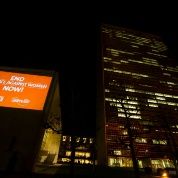Violence towards women must stop. That is the message being broadcast loud and clear across the world Tuesday during the U.N.-backed International Day for the Elimination of Violence against Women.

The Latin American and Caribbean region is no exception. It is an interesting region to compare to the rest of the world as long-held stereotypes still paint the region's men as “macho,” violent or having derogatory attitudes toward women.
While those attitudes are damaging, the most recent studies show that while it is not the worst region in the world for women, when it comes to violence, it is not very good news for Latinas and Caribbean women.
RELATED: The True Cost of Violence Toward Women
FACT: For 30% of women worldwide, their first sexual experience was forced. #16days #orangeurhood via @SayNO_UNiTE pic.twitter.com/WTJhni51aP
— FHI 360 (@FHI360)
November 25, 2014
The World Health Organization figures show the region to have the second lowest incidence of partner and non-partner violence toward women in the world. However, this number is still too high.
Over one third of the region's women report incidents of intimate or sexual violence. In turn, non-partner violence accounts for the experience of around one-third of those women, making intimate violence by partners to be by far the biggest threat to the region's women.

WHO “Global and regional estimates of violence against women: prevalence and health effects of intimate partner violence and nonpartner sexual violence.” 2013.
But the real problem is revealed in a different WHO report, showing that between 28 and 64 percent of the region’s women do not report the violence they experience.
One of the most important reasons violence toward women must be eradicated is the wider societal effects.
Dr. Mirta Roses Periago, Pan American Health Organization director, explains in the forward to the “Violence Against Women in Latin America and the Caribbean: a comparative analysis of population-based data from 12 countries” study:
“When women experience violence, their children suffer. Growing evidence suggests that when children witness or suffer violence directly, they may be at increased risk of becoming aggressors or victims in adulthood. Furthermore, violence against women and violence against children often co-occur in the same households.”
Many Central American countries are battling a phenomenon of gender-motivated killings. U.N. Women reports that 14 of the 25 countries with the worst femicide rates are in Latin America, and especially the Central American countries of Honduras, El Salvador, Guatemala and Nicaragua. Femicide also accounts for seven deaths in any 24-hour period in Mexico, with just 10 people sentenced for the crime from 2012-2013.
While South America's women may not be killed for their gender as often as their Central American sisters, there is much work still to be done.
Ecuador's government is taking strong action on violence against women in order to address that one of every four women there has been sexually violated and that that six of every 10 women experience some type of physical or emotional violence.
Emotional violence, or psychological abuse, can lead to indirect deaths, the WHO explains in this flowchart:

Emotional and psychological abuse is the focus of a current public health campaign in Caracas. “Words Kill: If you love them, don’t abuse them” is the name of the anti-gender violence campaign launched in Venezuela this week by the Ministry for Women and Gender Equality.
However, it's not all bad news. In reality, female empowerment and feminism in the region is alive and well. It is one of the strongest parts of the world for political integration of women, with some countries establishing affirmative action. The Latin American Feminist Summit is the longest-running feminist gathering in the world.
While the region must make strides to reduce violence against women, in other equality indicators, it surpasses many so-called developed countries.
The Global Gender Gap report, which ranks gender equality in the realms of health, education, economy and politics, ranked Nicaragua sixth, far ahead of most Western nations, while Ecuador, 21st, ranks above European countries like the United Kingdom, Luxembourg and Spain. Cuba, Argentina, Barbados, the Bahamas, Peru, Panama, Costa Rica and Trinidad & Tobago all make it into the top 50, succeeding most Eastern European countries, as well as economic powerhouses like China (87th) and India (114th).
This will be little consolation to women suffering violence in the region, but with greater equality comes a greater voice.
As Latin American and Caribbean women are empowered in society at large, the more they will be able to highlight inequality elsewhere, and act as spokespeople for those who are too vulnerable to do it themselves.
Peru's female politicians are leading examples on this international day of awareness.
#envivo Congresistas participan en acto por la eliminación de la #ViolenciacontralaMujer. pic.twitter.com/GXCqTQcAEw
— TVPeruPE Noticias (@noticias_tvperu)
November 25, 2014